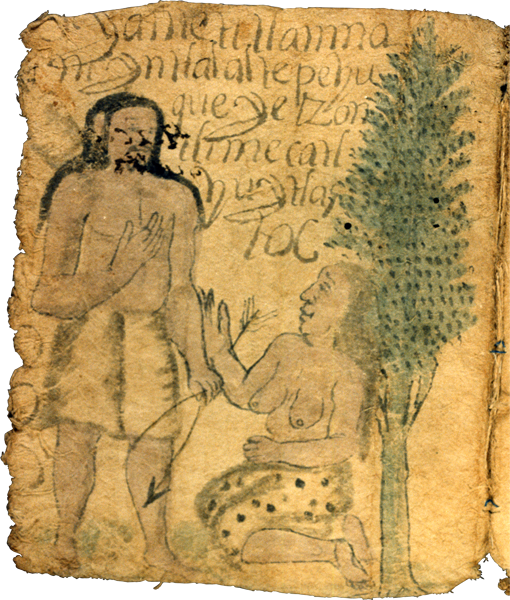Bk. IV, f. 1v., indigenous couple (pre-Hispanic)
This is a detail of two figures, appearing in Book IV, folio 1 verso. One is an indigenous man with long black hair, possibly a mustache, wearing what appears to be an animal skin from his waist to his knees, a quiver on his back (not visible here), and carrying an arrow and possibly a bow in his left hand. He stands over an indigenous woman, seated on the ground with her legs tucked under her, wearing a spotted animal skin skirt and no blouse. Her breasts are bare, as are her feet. His feet and chest are also bare. He is gesturing with his right hand over his heart or chest. She is gesturing with her right hand held up toward him. Her left hand is at her waist. Both figures have their hair long and flowing.
These two figures represent a couple in pre-Hispanic times, probably an autocthonous pair who spawned offspring who migrated into this region or who were among the first settlers themselves. Their use of animal skins, his lack of a cape knotted at his shoulder, and her long hair all convey a "pre-Civilized" or "Chichimec" state of existence in the language of the indigenous painters of this school. [SW]
pareja indígena (era precolombina)
Este es un detalle de dos figuras. En esta escena vemos a un hombre indígena con pelo largo, posiblemente un bigote, vestido de lo que parece ser una piel animal desde su cintura a las rodillas, una aljaba en la espalda y cargando una flecha y posiblemente un arco en su mano izquierda. Está parado al lado de una mujer indígena, arrodillada en el piso viestida en una fallda de piel de animal con manchas y sin blusa. Sus pechos están descubiertos como así también sus pies. Los pies del hombre y su pecho también están descubiertos. El hombre aparece gesticulando con su mano derecha a la altura del corazón, y ella gesticula con su mano derecha apuntando hacia él. Su mano izquierda se encuentra a la altura de su cintura. Ambas figuras tienen el pelo largo y suelto.
Estas dos figuras representan a una pareja de tiempos prehispánicos, probablemente un par autóctono que engendró descendientes que migraron hasta la region o quizás estaban entre los primero fundadores. El uso de pieles de animales, así como sus cabellos largos llevan a pensar que éstos individuos pertenecían a una “pre civilización” o“chichimec” estado de existencia en el lenguage de los pintores indígenas de esta escuela.

